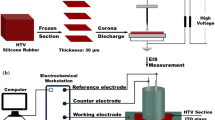Abstract
The present work investigates the performance of electrically stressed silicone rubber insulating material in a cyclic salt fog test. Corona Inception Voltage due to water droplet initiated discharges changes after salt fog ageing. The Ultra High Frequency signals radiated during corona discharge activity under AC voltages have a frequency span of 0.8–1.5 GHz, whereas under DC voltages span lies in the range of 0.5–1.5 GHz. Contact angle reduces with the increase in number of salt fog ageing cycles. Surface potential accumulation studies indicate that salt fog aged silicone rubber shows characteristic variation in accumulated potential magnitude and the decay characteristics. Further tdv/dt of surface potential decay characteristics enables to understand the charge penetration depth. Weight loss studies and surface roughness analysis during salt fog test are used to quantify the amount of damage.













Similar content being viewed by others
References
Du BX, Jiang JP, Zhang JG, Liu DS (2016a) Dynamic behaviour of surface charge on double-layer oil-paper insulation under pulse voltage. IEEE Trans Dielectr Electr Insul 23:2712–2719
Du BX, Li A, Li J (2016b) Effects of AC and pulse voltage combination on surface charge accumulation and decay of epoxy resin. IEEE Trans Dielectr Electr Insul 23:2368–2376
Gorur RS, Mantensinas J, Varadadesikam L (1997) A laboratory test for tracking and erosion resistance of HV outdoor insulation. IEEE Trans Dielectr Electr Insul 4:767–774
Kumagai S, Marungsri B, Shinokubo H, Matsuoka R, Yoshimura N (2006) Comparison of leakage current and ageing of silicone rubbers and porcelain in both field and salt-fog tests. IEEE Trans Dielectr Electr Insul 13:1286–1302
Kumara S, Ma B, Serdyuk YV, Gubanski SM (2012) Surface charge decay on HTV silicone rubber: effect of material treatment by corona discharges. IEEE Trans Dielectr Electr Insul 19:2189–2195
Marungsri B, Watanabe S, Gautum BK, Shinokubo H, Matsuoka R, Kumagai(2004) Effect of test conditions on ageing deterioration of silicone rubber housing material for outdoor polymer insulators. In: Proc international conference solid dielectrics (ICSD 2004), pp 324–327
Molinié P (2005) Measuring and modelling transient insulator response to charging: the contribution of surface potential studies. IEEE Trans Dielectr Electr Insul 12:939–950
Molinié P, Goldman M, Gatellet J (1995) Surface potential decay on corona-charged epoxy samples due to polarization processes. J Phys D Appl Phys 28:1601–1610
Sarathi R, Mishra P, Gautam R et al (2017) Understanding the influence of water droplet initiated discharges on damage caused to corona-aged silicone rubber. IEEE Trans Dielectr Electr Insul 24:2421–2431
Venkatesulu B, Thomas MJ (2011) Long-term accelerated weathering of outdoor silicone rubber insulators. IEEE Trans Dielectr Electr Insul 18:418–424
Zhang G J, Shen WW, Mu HB, Deng JB (2012) Surface trapping parameters of solid dielectrics: novel measurement method and insulation condition characterization. In: IEEE international conference on condition monitoring and diagnosis (CMD 2012), pp 480–484
Author information
Authors and Affiliations
Corresponding author
Rights and permissions
About this article
Cite this article
Mishra, P., Gayathri, C.S. & Sarathi, R. Influence of Salt Fog Test on Silicone Rubber Insulating Material Under AC and DC Voltages. INAE Lett 4, 1–6 (2019). https://doi.org/10.1007/s41403-018-0059-7
Received:
Accepted:
Published:
Issue Date:
DOI: https://doi.org/10.1007/s41403-018-0059-7




